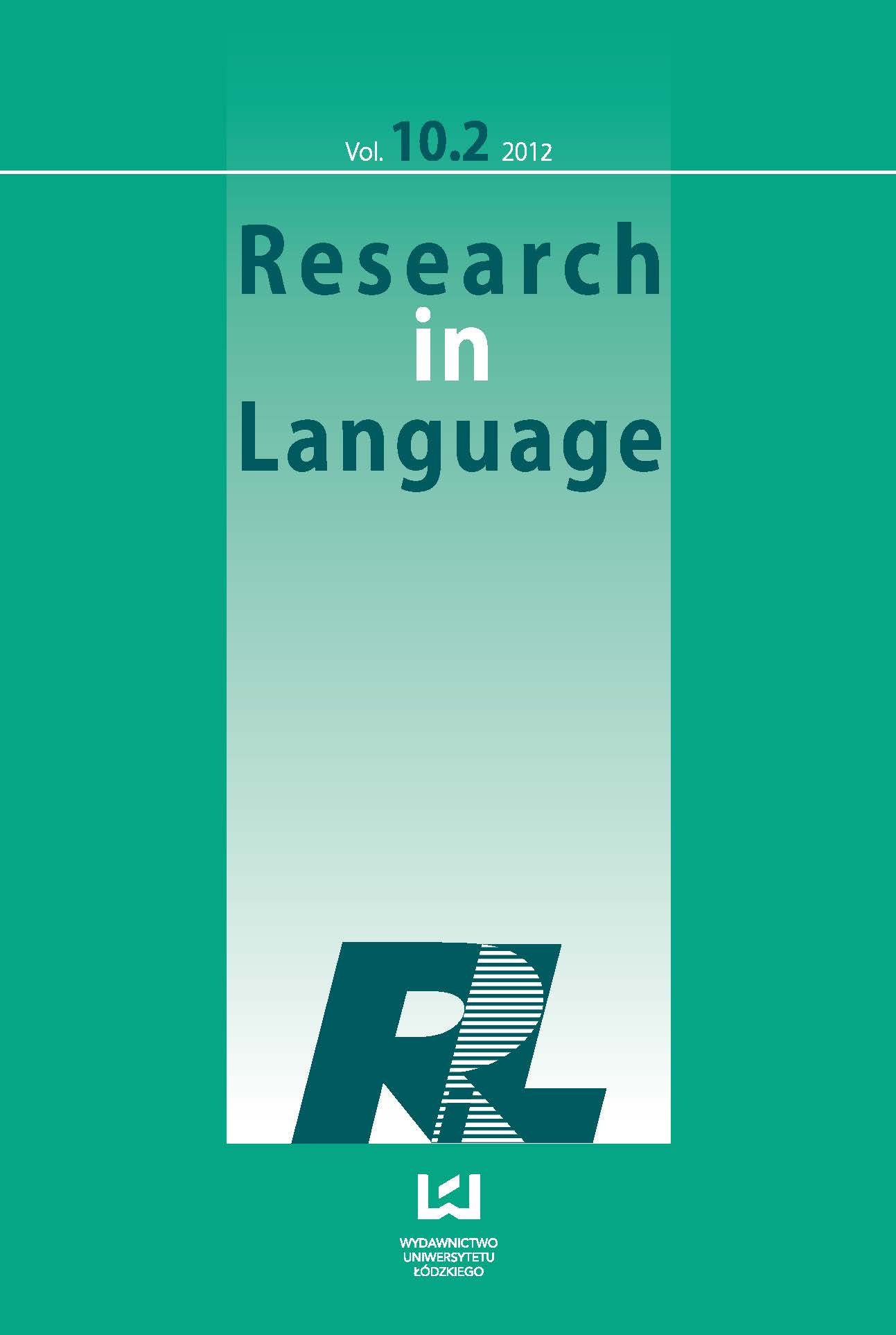Measuring Vowel Duration Variability in Native English Speakers and Polish Learners
DOI:
https://doi.org/10.2478/v10015-011-0034-9Abstract
This paper presents a set of simple statistical measures that illustrate the difference between native English speakers and Polish learners of English in varying the length of vocalic segments in read speech. Relative vowel duration and vowel length variation are widely used as basic criteria for establishing rhythmic differences between languages and dialects of a language. The parameter of vocalic duration is employed in popular measures such as ΔV (Ramus et al. 1999), VarcoV (Dellwo 2006, White and Mattys 2007), and PVI (Low et al. 2000, Grabe and Low 2002). Apart from rhythm studies, the processing of data concerning vowel duration can be used to establish the level of discrepancy between native speech and learner speech in investigating other temporal aspects of FL pronunciation, such as tense-lax vowel distinction, accentual lengthening or the degree of unstressed vowel reduction, which are often pointed out as serious problems in the acquisition of English pronunciation by Polish learners. Using descriptive statistics (relations between personal mean vowel duration and standard deviation), the author calculates several indices that demonstrate individual learners' (13 subjects) scores in relation to the native speakers' (12 subjects) score ranges. In some tested aspects, the results of the two groups of speakers are almost cleanly separated, which suggests not only the existence of specific didactic problems but also their actual scale.
References
Avery, P. and S. Ehrlich. 1992. Teaching American English Pronunciation. Oxford: Oxford University Press.
Google Scholar
Boersma, P. 2001. Praat, a system for doing phonetics by computer. Glot International 5 (9/10): 341-345.
Google Scholar
Bryła, A. 2010. Phonetic properties of Euro-English - empirical evidence. In Issues in accents of English 2: Variability and norm, ed. E. Waniek-Klimczak, 37-60. Newcastle-upon-Tyne: Cambridge Scholars Publishing.
Google Scholar
Dellwo, V. 2006. Rhythm and Speech Rate: A Variation Coefficient for ΔC. In: Language and Language-processing, eds. P. Karnowski and I. Szigeti, 231-241. Frankfurt am Main: Peter Lang.
Google Scholar
Dziubalska-Kołaczyk, K., A. Bogacka, D.Pietrala, M. Wypych and G. Krynicki. 2006. PELT: an English language tutorial system for Polish speakers. MULTILING-2006, paper 012.
Google Scholar
Gonet, W., J. Szpyra-Kozłowska, and R. Święciński. 2010. The acquisition of Vowel Reduction by Polish students of English. In Issues in accents of English 2: Variability and norm, ed. E. Waniek-Klimczak, 291-308. Newcastle-upon-Tyne: Cambridge Scholars Publishing.
Google Scholar
Grabe, E., B. Post and F. Nolan. 2001. The IViE Corpus. Department of Linguistics, University of Cambridge. http://www.phon.ox.ac.uk/IViE Retrieved 7 September 2006
Google Scholar
Grabe E. and E. L. Low. 2002. Durational variability in speech and the rhythm class hypothesis. In Laboratory Phonology 7, eds. C. Gussenhoven and N. Warner, 515-546. Berlin, New York: Mouton de Gruyter.
Google Scholar
Hewings, M. 2004. Pronunciation Practice Activities. Cambridge: Cambridge University Press.
Google Scholar
Loukina, A., G. Kochanski, B. Rosner, C. Shih and E. Keane. 2011. Rhythm measures and dimensions of durational variation in speech. Journal of the Acoustal Society of America 129/5: 3258-3270.
Google Scholar
Low E. L., E. Grabe and Nolan F. 2000. Quantitative characterisations of speech rhythm: syllable-timing in Singapore English. Language and Speech 43: 377-401.
Google Scholar
Luke, K.-K. and J. C. Richards. 1982. English in Hong-Kong: Functions and status. English World-Wide 3: 147-164.
Google Scholar
Nowacka, M. 2008. The Phonetic Attainment in Polish University and College Students of English. A Study in the Productive and ReceptivePronunciation Skills. Unpublished Ph.D. dissertation. Maria Curie-Skłodowska University, Lublin.
Google Scholar
Porzuczek, A. 2010. The weak forms of TO in the pronunciation of Polish learners of English. In Issues in accents of English 2: Variability and norm, ed. E. Waniek-Klimczak, 309-324. Newcastle-upon-Tyne: Cambridge Scholars Publishing.
Google Scholar
Porzuczek, A. (in press). The timing of tone group constituents in the advanced Polish learner's English pronunciation. Katowice: Wydawnictwo Uniwersytetu Śląskiego
Google Scholar
Ramus, F., M. Nespor and J. Mehler. 1999. Correlates of linguistic rhythm in the speech signal. Cognition 72: 1-28.
Google Scholar
Sobkowiak, W. 1996. English Phonetics for Poles. Poznań: Bene Nati
Google Scholar
Szpyra-Kozłowska, J. 2003. The Lingua Franca Core and the Polish Learner. In Dydaktyka fonetyki języka obcego, eds. W. Sobkowiak and E. Waniek-Klimczak, 193-210. Płock: Wydawnictwo Naukowe PWSZ w Płocku,.
Google Scholar
Waniek-Klimczak, E. 2005. Temporal Parameters in Second Language Speech. Łódź: Wydawnictwo Uniwersytetu Łódzkiego.
Google Scholar
White, L. and S. L. Mattys. 2007. Calibrating rhythm: First language and second language studies. Journal of Phonetics 35: 501-522.
Google Scholar
Downloads
Published
How to Cite
Issue
Section
License

This work is licensed under a Creative Commons Attribution-NonCommercial-NoDerivatives 4.0 International License.










